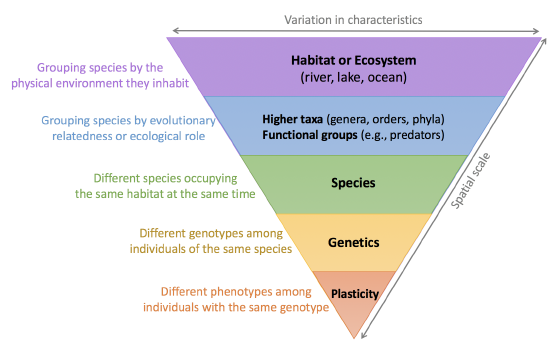4: Functional Diversity - Resource Acquisition
- Page ID
- 62270
 Scientists have estimated that there are ~8.7 million species on Earth. How does one planet support such enormous diversity of species? The answer relates to the impressive functional diversity (Fig 4.0.1) that organisms display – that is, the diversity in strategies and adaptations that different organisms have for surviving in their environment. The functional diversity sections address different strategies and adaptations for acquiring nutrients and resources from the environment, dealing with stressful environmental conditions (ex. heat stress), succeeding at or defending against predation, and successfully completing the life cycle.
Scientists have estimated that there are ~8.7 million species on Earth. How does one planet support such enormous diversity of species? The answer relates to the impressive functional diversity (Fig 4.0.1) that organisms display – that is, the diversity in strategies and adaptations that different organisms have for surviving in their environment. The functional diversity sections address different strategies and adaptations for acquiring nutrients and resources from the environment, dealing with stressful environmental conditions (ex. heat stress), succeeding at or defending against predation, and successfully completing the life cycle.
This first chapter will focus on resource acquisition, particularly the two primary strategies for acquiring glucose (sugar) for respiration: autotrophy and heterotrophy. Autotrophs generate their own glucose through processes like photosynthesis. Heterotrophs acquire glucose by feeding on material in the environment. Both autotrophs and heterotrophs must obtain other nutrients besides glucose from the environment and have a wide variety of strategies and adaptations to do so. You will study a variety of resource acquisition strategies and their associated traits in Laboratory 2: Resource Acquisition in Eukaryotic Organisms.
Figure \(\PageIndex{1}\): Schematic of the magnitude and type of diversity exhibited at different scales. This section focuses on functional group diversity. Figure by L Gerhart-Barley.
Title Image Credit: https://commons.wikimedia.org/wiki/F..._--_3510-4.jpg
- 4.1: The Principle of Allocation
- Functional diversity is driven the Principle of Allocation which states that each individual organism has a finite (limited) quantity of resources that it can use for all necessary life processes, including growth, reproduction, acquiring nutrients and resources, escaping predators or pathogens, etc.
- 4.2: Resource Acquisition in Plants
- Plants obtain the majority of the nutrients they need, including water, nitrogen, phosophorus, etc from the soil through their roots. The only exception is carbon, which is taken up in the form of carbon dioxide in the atmosphere.
- 4.3: Resource Acquisition in Animals
- Resource acquisition operates somewhat differently in animals than in plants. As heterotrophs, animals must consume all nutrients they require, including glucose. Animals have a variety of acquisition strategies available to them, depending on which trophic level and ecosystem they inhabit.


